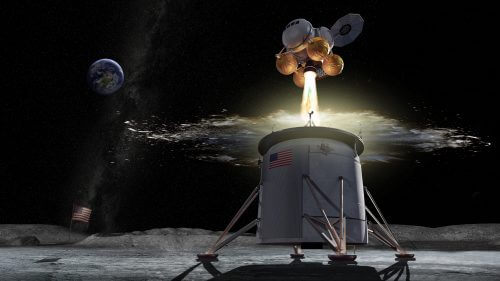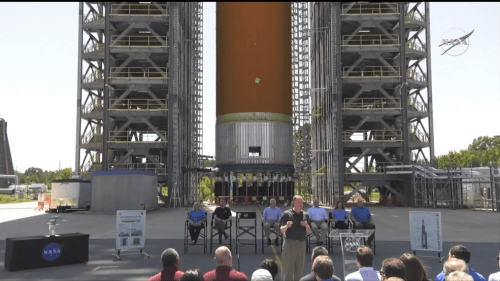This is what NASA Administrator Jim Bridenstine said at an announcement event in Huttonsville against the background of all the fuel of the giant SLS launcher designed to return people to the moon and from there to Mars

NASA Administrator Jim Bridenstine announced Friday at a press conference at the Space Center in Huntsville, Alabama, the center's new role to lead the space agency's manned landing and return to the Moon program through 2024.
"Marshall Space Flight Center is the birthplace of the American space program." Alabama Sen. Moe Brooks said. "It was the scientists and engineers here who designed, built, tested and helped launch the huge Saturn launcher that carried astronauts on the Apollo missions to the moon," Brooks said. "Marshall has unique capabilities and expertise not found in other NASA centers. I am pleased that NASA has chosen Marshall to lead a key component of America's return to the Moon and lead in the Artemis era. Thanks to Director Bridenstine for traveling here to share the great news in person.
Bridenstine made the announcement alongside the entire liquid hydrogen engine that will be used by the Space Launch System (SLS) launcher that will fly the next astronauts to the moon. He emphasizes that this is the next man (the 13th) and the first woman to fly to the moon.
"We greatly appreciate the support shown here today by the representatives of Congress for NASA's Artemis program and for America's return to the Moon, on the way to humanity's greatest achievement - landing astronauts on Mars," Bridenstine said. "We are focusing on NASA's integrated approach that uses the technical capabilities of many centers. Marshall has the right combination of expertise and experience for this mission-critical part.”
The knowledge and expertise gained at Marshall over the years in the development and construction of the propulsion systems, engineers at Marshall will work with American companies to quickly develop, integrate and demonstrate a human landing system that can launch astronauts to the (space station) lunar gate, pick up the astronauts and transport them between the gate and the lunar surface.

Marshall Space Flight Center, and North Alabama, has played a central role in all American manned missions since Mercury 7.. I am proud that Marshall was chosen to be the lead for the Landers program, Aderholt said. "I am also very proud that Marshall designed and built the rocket system and launchers that will enable the manned flights to the moon and Mars. We look forward to working with our industry partners and NASA partners from around the country."
NASA's Johnson Space Center in Houston, which manages the manned components of the Artemis program including the Moongate, Orion, the commercial manned spaceflight project and the International Space Station, will oversee all aspects related to preparing the lander and training the astronauts to work inside it. The Johnson Gepp Space Center will manage all Artemis missions, starting with Artemis 1, NASA's Deep Space Exploration Systems Integrated Test Vehicle.
NASA recently released a draft plan and requested comments from American companies interested in supplying components for the Integrated Human Landing System. A final version will be released in the coming months. NASA's manned program for lunar exploration is based on a two-phase approach: the first phase focuses on the rapid construction of a lander that could allow the first crew to land on the moon within five years. Let's learn on the moon to prepare for the next big leap - sending astronauts to Mars.
More of the topic in Hayadan:
- The Aerospace Industry will develop a lunar lander (unmanned) for one of NASA's subcontractors in the return to the moon project - Artemis
- Project Artemis and the return to the Moon: NASA's plans
- The Moongate satellite - one of the components of the Artemis program - will be purchased from a private company

3 תגובות
It seems that the entire article is a Google translation of an article written in English and that the scientist didn't even bother to read it before clicking send... It's a shame, usually the articles are of a high level...
Lorem Ipsum:
What you wrote made me laugh and amuse me a lot, but also made me sad - because it's simply true...
* … unless during that time SpaceX has an unplanned mishap, with dead astronauts…
Until they finally build and test the SLS (advanced block 2, which will be able to reach the moon), and the aforementioned lunar lander, and the "Moon Gate" station, and launch all this equipment, and also the astronaut, and the astronaut (don't forget!!) , they will arrive just in time for the opening festivities of SpaceX's ice cream stand on the moon.